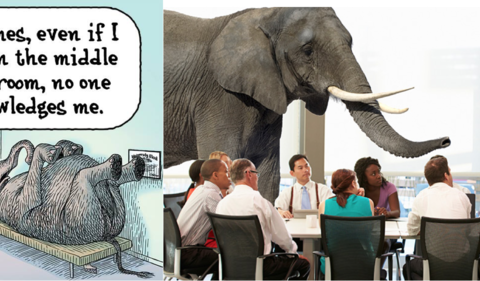Whether it’s a meditation room in the office, subsidized yoga classes, or smoothie-making workshops, companies around the world are finding ways to bring mindfulness to work. And it’s not just employees getting involved—even high-flying executives are swearing by the benefits of mindfulness strategies.
What is mindfulness?
So what is mindfulness, anyway? And why is everyone hopping on board with this trend?
According to executive coach, leadership development specialist, and psychiatrist, David Brendel, mindfulness is “a mental orientation and set of strategies for focusing one’s mind on here-and-now experiences.” These strategies can involve “abdominal muscle movements during respiration or chirping of birds outside one’s window.”
Mindfulness originated in Eastern philosophies such as Buddhism and Taoism but has more recently been stripped of most of its spiritual aspects to fit a more secular western audience.
Jason Marsh, director of programs for the Greater Good Science Centre at the University of California, says mindfulness is “a moment-to-moment awareness of your thoughts, feelings, and bodily sensations. It’s a state of being attuned to what’s going on in your body and in the surrounding environment—being in the present moment without thinking about the future or what happened in the past.”
A big part of mindfulness is acceptance of what’s happening around you and how you’re feeling, says Marsh. “Whatever you’re thinking and feeling at that moment is neither right nor wrong,” he says. “You notice it, and accept it, and move onto the next moment without getting caught up in judging what you’re thinking or feeling.”
While mindfulness practice often comes in the form of mindfulness meditation, Marsh says this isn’t the only option – “Once you learn mindfulness skills, you can practice them at almost any moment of the day—sitting at your computer, stuck in traffic, even eating. And there’s also growing interest in using the practice of mindfulness in the workplace to provide a buffer against stress.”
So why are executives and investors hailing this age-old form of quieting and focusing your mind? Mindfulness has been shown to have many health benefits. NICE, the UK’s National Institute for Clinical Excellence supports mindfulness as a treatment for people with recurring depression, as it’s been shown to reduce the recurrence rate by more than 40 per cent over twelve months.
Mindfulness-based treatment is also recommended by thirty per cent of British GPs.
Mindfulness training has been shown to ease stress and anxiety. Jason Marsh says mindfulness “fosters positive emotions and helps provide resilience against negative experiences.” He also says there’s evidence that mindfulness practice can promote empathy and compassion, as well as concentration and focus.
There haven’t been many rigorous studies of mindfulness effects in the workplace yet, but Marsh says some preliminary research suggests a mindfulness program at work may increase productivity and reduce time off needed to recover from illness.
Finally, one small study showed mindfulness may help to boost the immune system by serving as a buffer against stress.
Having said that, there’s a real need for more research into the effects of mindfulness—both at work and at home. Lesley University in the U.S. is offering a first-of-its-kind Master of Arts in Mindfulness Studies, but the curriculum is lacking any kind of research component. As Fast Company writer Rebecca Greenfield says, this would be “an obvious way to legitimize and spread the discipline.”
Is mindfulness at work all it’s cracked up to be?
As mindfulness gains mind share among westerners, it’s also becoming more common in the workplace. Google’s Sydney office has a meditation room, and on-site yoga classes, while a recruitment company in Sydney encourages employees to use adult colouring books to relieve stress and increase mindfulness. One law firm runs “health and wellbeing” seminars that “have included on-site massages, lessons in making smoothies and juices and seminars on nutrition and resilience.”
At first glance it might seem like a wonderful trend—managers are taking an interest in their employees’ health and wellbeing, after all, and encouraging practices that help team members deal with stress more effectively.
But not everyone agrees mindfulness at work is the panacea it’s being touted as.
David Brendel, for instance, tells the story of a group of employees whose stress levels were actually increased by the anxiety and discomfort that came from participating in regular, mandatory group mindfulness sessions at work. “Many participants came to dread the exercise,” he says, “some of them felt extremely awkward and uncomfortable, believing that mindfulness practices should be done in private.”
Brendel says this continued for weeks until several group members finally found the courage to suggest the daily exercises be optional.
Mindfulness, Brendel says, is rooted in ideas of looking after oneself. “Imposing it on people in a top-down manner degrades the practice and the people who might benefit from using it of their own volition.”
Brendel also says some people end up taking mindfulness too far, using those strategies “to avoid critical thinking tasks.” He says, “I’ve worked with clients who, instead of rationally thinking through a career challenge or ethical dilemma, prefer to disconnect from their challenges and retreat into a meditative mindset. The issue here is that some problems require more thinking, not less.”
Mindfulness strategies, says Brendel, can prime the mind for sounder rational thinking, but it shouldn’t replace critical thinking entirely. Mindful meditation should always be used to enhance rational and analytical thought, she says.
And finally, perhaps the most pernicious side effect of the mindfulness trend is the threat of stressful work being accepted due to the mitigating effects of workplace wellness programs.
Professor of work and health at the University of Sydney, Philip Bohle, says mindfulness strategies can help employees become more resilient and deal with excessive demands at work, but this is only a good thing if “those demands are short-lived bumps in workload.”
In workplaces with “chronically excessive” workloads, Bohle worries leaders may think mindfulness programs are the answer. “Just finding ways to make workers more resilient to cope better with stress and demands is like putting a Band-Aid on that,” he says.
Understanding the need for mindfulness in the workplace
Bohle is not the only one who thinks this trend may be missing the mark. Emma Barnett, presenter of BBC Radio 4 documentary ‘Mindfulness: Panacea or Fad?’, says we need to look at the underlying cause of the rush to bring mindfulness training into the workplace.
Barnett says work-related stress is estimated to cost British business more than three billion pounds a year—and this, she says, is the real problem.
It’s our lives and how we lead them that really needs to change, according to Barnett, if we are to improve our mental well-being. “Ironically this is what the Buddhist version of mindfulness teaches – a moral and ethical worldview – as opposed to this new corporatized Mindfulness – which in the long term will do as much as a McDonald’s Happy Meal to sate a person’s gnawing hunger for a richer life,” he says.
Brigid Delaney, writing for The Guardian, agrees that the corporate take-up of mindfulness is not necessarily a good thing. These days, says Delaney, something that was once mostly free and welcoming to all is “tied up in millions of dollars’ worth of expensive luxury retreats, apps for your smartphone and celebrity endorsements.”
Mindfulness strategies and meditation don’t need debunking, according to Delaney. Rather, she suggests we spend our time thinking about why we feel the need for these strategies in the first place. “What is the communal Om,” she asks, “except a cry for help in a competitive, atomised and hyper-connected world where anxiety is a given?”
The rush of executives and company founders to try mindfulness themselves and thrust it on their employees is a sign of an overworked, overtired, stressed out workforce. “What we need is more silence and space,” says Delaney. “We need to switch off the machine that is in our heads (and the one in our hands).”
New York Times writer Adam Grant agrees that there are plenty of ways to get the space and relaxation you need. Many of the purported benefits of mindfulness strategies can also be found in other activities, Grant says, like exercise and quality sleep.
If meditation or other mindfulness practices are useful to you, Delaney says, there’s nothing wrong with that. But she urges you to make them your own. “Don’t necessarily accept the packaged, commodified, watered down version of what you think meditation is,” she says.
—-
Research into mindfulness strategies and their benefits is still early, so there’s a lot we don’t know. The most reliable benefit that’s been shown so far is the ability to deal better with stress through mindfulness strategies.
Source: Culture Amp
By- Alexis Croswell








